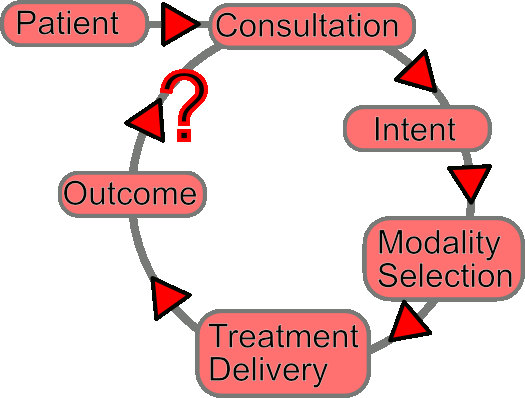IHERO Electronic Patient Record
Interested Participants
If you're interested, please add your name and contact info.
- Colin Field, Medical Physicist
- Cross Cancer Institute, Edmonton, AB, Canada
- email: cfield@cancerboard.ab.ca
- phone: 780-432-8625
- Mahmoud M. EL-GANTIRY,Radiation Oncologist,
- National Cancer Institute – Cairo University, Kasr EL-Aini street, Kornish El-Nil, Fom El-Khalig, 11796, Cairo, Egypt.
- Cellular Tel: +2-0101799845.
- Fax: +202-23635083.
- e-mail: melgantiry@yahoo.com
- Andrew Miller, Radiation Oncologist
- Illawarra Cancer Care Centre, Wollongong, NSW 2500 Australia.
- email: alexisandrew@gmail.com
- phone: +61409654239
- Tony S. Quang, MD, Radiation Oncologist
- VA Puget Sound Health Care System & University of Washington Medical Center
- 1660 S. Columbian Way, MS S-111-RadOnc, Seattle, WA 98108, U.S.A.
- Phone: +1-206-768-5356
- Fax: +1-206-768-5331
- Email: tquang@u.washington.edu
- http://radonc.md
Links to Other Organizations working on this Task
- HIMMS
- ???
Required Data Elements
An overarching requirement is that the Knowledge Representation of data elements within the database structures defined match that of the oncological thought processes. In this way, clinical data be fragmented into a database storage schema and then re-constituted without loss of knowledge. This requirement calls for an EPR which has a strong diagnosis/time based approach to data that correctly indicates sequencing and the oncological reasons for events. This thinking is not present in some very widespread Oncology Information Systems (elaboration can be provided if required).
The present and unchanging process of patient management follows the following pattern:
| Patient > | Consultation > | Intent > | Modality Selection > | Treatment Delivery > | Outcome |
|---|---|---|---|---|---|
Unique Identifier Demographics
|
Diagnosis
Stage
Prognosis/Risks
Physiology
Eligibility/Exclusion
|
One of the following words can be assigned to describe the general oncological intent. This is similar to describing my intent in travel - to get from my home to the Empire State Building. It is not "by plane" because no plane leaves from my house or lands at the ESB (well, never again hopefully). It's the following modalities: neoadjuvant drive > neoadjuvant train > neoadjuvant walk > primary plane > adjuvant walk > adjuvant taxi > adjuvant walk. limited choices
|
This section results in the selection of a pair of terms - a modality with a descriptor, such as 'primary surgery', or "primary radiotherapy with concurrent chemotherapy" or "primary radiotherapy with neoadjuvant, concurrent and adjuvant hormone therapy" name of modality
modality hierarchy
|
This is a detail section which will vary for each modality, but provide the details of what was undertaken. surgery
radiotherapy
chemotherapy
hormone therapy
|
On treatment Effects
Post Treatment Effects
|
Demographics
- need a way to use demographics to produce a unique ID to produce anonymous records if transferred
Diagnosis
- utilizing a structure which is mapped (via UMLS)
- PRESENT
- using ICD .... 9 (USA) 10 (AU, NZ, UK?)
- predominantly for malignant diagnosis alone
- already includes structured morphology nomenclature (e.g. SNOMED
- FUTURE
- include all benign diagnoses (these are likely to be be transferrable from other specialties and GPs)
- expanded morphology descriptors that include immunohistochemical patterns, genetic changes
- PRESENT
Stage
- utilizing a structure which is mapped (via UMLS)
- PRESENT
- use AJCC/UICC
- FUTURE
- utilizing more specific anatomical definitions
- derived from CT/MRI/PET anatomy (?DICOM-SR subset)
- described in an Anatomical Ontology
- utilizing more specific anatomical definitions
- PRESENT
Intent of Oncological Plan
- PRESENT
- always determined implicitly
- FUTURE
- always stated explicitly
Employed Modalities
- PRESENT
- usually able to be determined from reading a narrative
- formal notation usually only determined for one's own modality
- confusion of descriptors with intent
- variable language describing intent
- FUTURE
- explicit description of all other modalities and their descriptors
- determined after intent quantified
- standardised nomenclature for descriptors
Modality Details
- PRESENT
- encapsulated within DICOM-RT
- no accepted specification for chemotherapy
- FUTURE
- DICOM-RT housed in PACS with viewing capabilities
- Common chemotherapy specification
Establishment of Iterative Disease Management Loop
These Loops will determine how events such as recurrence will be coded and what subsequent data will be supplied. This is exactly the same sequence as occurs initially, except that the loop is not 'completed' until an outcome assessment is finished. If the assessment is that there is recurrent disease then the loop is re-entered and diagnosis reviewed, re-staging (using the same coding structures as the first time) and re-assessment for intent and modality is undertaken.
AAM 08:33, 18 January 2008 (CST)
